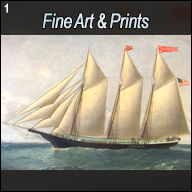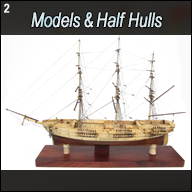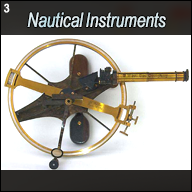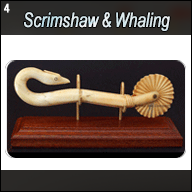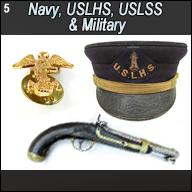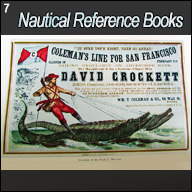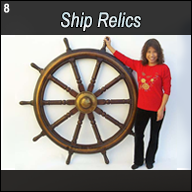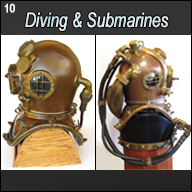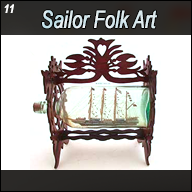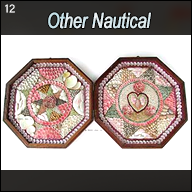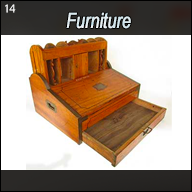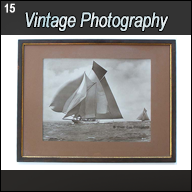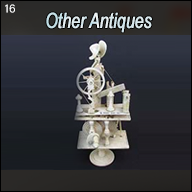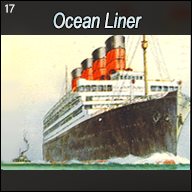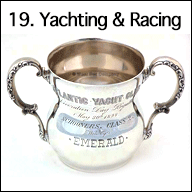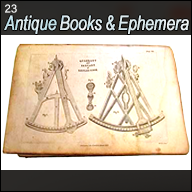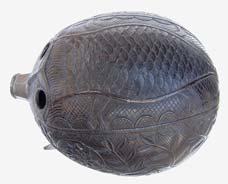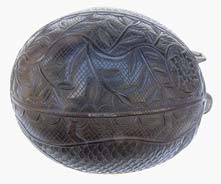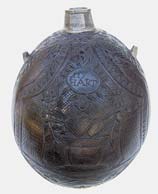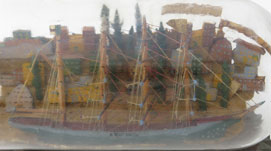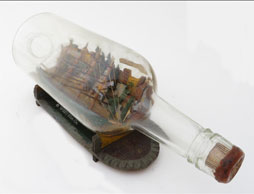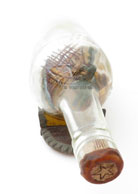11. Sailor Folk Art
Prices in U.S. Dollars are in GREEN
 |
11.81 SHIP IN A BOTTLE. Charming sailor-made ship in an early pinch bottle. This detailed rendering made by its skillful maker depicts a 3-masted bark under full sail plying a green putty sea. The ship, identified as the “PORT DOVER” on the starboard trail board, exhibits a realistic bow wake as it slices through the water. Adding to its realism, it has genuine cloth sails, 3 deck houses, and a stern steering station. It flies 2 flags from the spanker. The 3-sided dimpled bottle is especially clear and bright. It measures 6 inches long by 3 3/4 inches wide on each of its 3 sides. A little gem which is a perfect excellent example of this form of sailor folk art for any serious nautical collection. 295 |
 |
 |
| dimple | ship |
 |
11.82 MINIATURE PEN KNIFE. Professional grade folding knife of unusual proportions. This incredibly small working pocket knife is just shy of 2 inches long closed and 3 1/8 inches long fully open. The contoured body is of pure ivory riveted in 3 positions to the inner metal structure. The steel blade with fingernail impression is a mere 1 ¼ inch long. It opens and closes smoothly and locks into position for use. The metal bolster of the knife is nicely decorated with 5 scribe lines on both sides. Excellent original condition showing great age but cherished use. 79 |
 |
 |
| reverse | closed |
 |
11.80 NAUUGHTY NELLIE KNIFE. Delightful mid-19th century sailor’s utilitarian pocket knife in the form of a classic “Naughty Nellie” lady’s leg from the Victorian era. This diminutive, actually miniature example, features a commercially forged high quality blade signed “URATIO, BARNES.” What is charming is the sailor/scrimshander then incorporated the mechanism into his own creation using carved whale tooth ivory to form an exotic and very functional pen knife. 3 7/8 inches long open and 2 3/8 inches closed. Very good original condition, noting the knife blade has been worn due to repeated sharpening. Truly a little gem which shows its lovely age! 189 Barnes is a district in South London, England on the banks of the Thames, River as visited by merchant shipping for the past several hundred years. |
 |
 |
| reverse | maker |
 |
11.79 SAILOR’s WEAPON. Remarkable mid-1800’s, probably earlier, sailor-made personal protection device known as a “cosh,” come along, black jack or head knocker. This particularly diminutive yet fearsome example is made of fine macramé sailor rope work using a variety of knots. The working end consists of a weighted ball (probably lead) covered in fine Spanish hitching extending to a column capped by a fine Turk’s head knot. It connects to a braided cord composed of 2 intertwined strands terminating in a larger Turk’s head knot which supports a thong. The overall length is 19 inches and the diameter of the working end is 1 ¼ inches. Lightweight, compact, yet very effective as a concealed weapon which would have packed a devastating knock-out or worse! Excellent original condition. The quality of the marlinspike seamanship demonstrated here cannot be overstated! 449 During the 18th and 19th centuries a sailor literally took his life in his hands when going ashore in a foreign port. Press gangs, "land sharks" and thieves lay waiting in every alley and dark corner to take advantage of an unsuspecting or inebriated victim. With pointed knives and guns prohibited aboard ship, it came down to the seasoned sailor to equip himself with an acceptable means of self defense. This most often evidenced itself in the form of a sailor's black jack -- also known as a "come along," head knocker, press-gang tool or "cosh." The owner/maker took great pride in this personal protective tool, lavishing great care and skill in its construction. |
 |
 |
| detail | handle |
 |
11.78 CAT-O-NINE TAILS. Extremely rare shipboard punishment tool known by sailors before the early19th century as the dreaded flogging device called the “cat of nine tails,” This very scare and elaborate macraméd example is meticulously woven in a seaman-like manner from ‘small stuff’ cotton twine. The name of this menacing device referred to the nine individual strands at the end of the whip. While this example appears to have been relatively harmless with Turk’s head knots at its ends, the most severe examples bore shards of glass or metal intended to seriously lacerate the hapless recipient. 895 |
 |
 |
| detail | handle |
 |
| flails |
 |
11.77 SAILOR’s BLACK JACK. Classic 19th century personal protection tool as carried by sailors in foreign ports during the 1800’s. This good example consists of a heavily weighted “working end” made of lead overlaid by tight woven leather in a plat sennet design forming diamonds. The connecting shaft has an internal wire which keeps it strong but very flexible, terminating in a knob with similar weaving. 8 inches long by 1 3/8 inches wide. Excellent original condition. 295 |
 |
 |
| detail | knob |
 |
11.76 SAILOR’s NEEDLE CASE. Classic mid-19th century or earlier sail maker’s needle case made of two turned wooden tubes joined in the middle. This fine example of working marlinspike seamanship has a meticulously finished macraméd surface done in tight Spanish hitching. The tubular case closes with a tight press fit. Of considerable note is the case contains several original sail canvas needles all varying in size, form and function. The case measures 6 3/8 inches long by 1 3/8 inches in diameter. The needles vary in length from 3 ¼ up to 4 ½ inches. One is signed “THORNHILL” and another is marked “VVI.” Overall condition is outstanding in all respects. A great example of 19th C. working sailor folk art from the great age of sail at a bargain price! 175 Such a needle case was not only a utilitarian item for effectively holding tools of the trade, but it also functioned as a demonstration of the sailor’s prowess in deck seamanship -- that being his ability to carve and decorate a personal tool in a seamanlike manner. This was an essential step in his “coming through the ranks.” It demonstrated his prowess in the foc’sle while gaining the acceptance of his shipmates. In a real sense, it could be considered his apprentice application. |
 |
| open |
 |
11.74 LIFERING FRAMED PHOTO. A most handsome and undervalued example of sailor folk art in the form of a carved wooden “lifering” frame housing the photograph of an early 1900’s British sailor. This meticulously carved and inlaid frame is made of mahogany with marquetry inlay of a different wood displaying the name of the ship “HMS GODETIA.” The center bears the clear image of a handsome young sailor in his flat hat and jumper with the lanyard of a boatswain’s pipe around his neck! This original early silverplate photograph is protected by old wavy glass. Flanking it on both sides are relief carvings of flowers, oddly in the form of anchors. Extending outward are 4 carved rope-like bands mimicking an actual life ring. Incredibly, on each side of this presentation are marquetry inlays of delicate butterflies done in fine detail! The top is equipped with a brass hanging bracket secured with copper nails. The rectangular opening on the back has 4 copper brackets holding the photograph. 11 ¾ inches in diameter. Fabulous original condition. The wooden inlays are really remarkable! The time spent on this presentation would dictate a price of many hundreds of dollars. However we are offering it for a bargain basement price. HAPPY NEW YEAR! 199 HMS GODETIA was an Arabis class sloop in the Royal Navy’s Fishery Protection Squadron. She was launched in 1916 with a displacement of 1,350 tons. While serving in the Arctic on May 9, 1923 the trawler LORD ASTOR of Hull, England was seized by a Russian gunboat off the coast of Murmansk for allegedly fishing illegally. The trawler was recaptured by GODETIA after she returned to Norway to re-coal and resupply. Thereafter GODETIA was relieved by HMS HAREBELL, command ship of the fishery protection cruiser squadron. GODETIA was broken up in 1937. |
 |
 |
| detail | back |
 |
11.72 SAILOR’s NEEDLE CASE. Classic mid-19th century or earlier sail maker’s needle case in two-part wooden construction. This unusually large example of working marlinspike seamanship features a meticulously macraméd surface done in tight Spanish hitching. The tubular case joins in the middle with a tight press fit. Of considerable note is that the case holds 25 original sail canvas needles of varying sizes! The case measures 6 3/8 inches long by 1 ¾ inches in diameter. The needles vary in size from 2 ¾ inches long up to 4 ¼ inches. Overall condition is outstanding in all respects. A great example of 19th C. working sailor folk art! 199 |
 |
 |
| closed | open |

|
11.71 SEA CHEST BECKETS. Very large, especially handsome matched pair of genuine mid-19th century American sailor-macraméd sea chest handles known as "beckets" in patriotic red, white and blue colors. The meticulously woven handles exhibit 5 forms of complicated knot-tying that only a seasoned veteran of the old maritime trade could produce. They are classic marlin spike examples made with a "puddinged" bolt passing through the two eyes of the becket loop terminating in star knots. The bolt is fitted with typical starburst leather washers on both sides of the becket loops. The loops were tarred for strength then painted in patriotic red, white and blue. The blue pigment has long since oxidized in its marine environment – a testament to age and actual use aboard a sailing ship with damp quarters. These beckets are extremely stout and in unusually fine condition. They measure 11 ¼ inches long by 6 inches wide at the widest. The distance from the bolt to the bottom of the becket is exactly 10 inches. Marlin spike ropework is an aspect of nautical collecting which, along with scrimshaw, epitomizes the finest of sailor folk art. 949 |
detail |
reverse |
knots |

|
11.68 SHIP IN BOTTLE. Without question one of the finest examples of its type ever made. We have handled scores of genuine sailor folk art bottle dioramas in our 40 year tenure, and this is certainly one of the very finest! It features a 4-masted sailing bark with sails furled, flying flags and pennants from all 4 masts. At the fore is the owner's flag. At the main is the house flag. The ship's name pennant "WILLIAM" flies from the mizzen. The aft mast flies the ship's call sign flag hoist. The "old duster" British ensign flies aft. Each of the masts carries 6 yard arms beautifully rigged with standing rigging and thimbles. Not only that, each or the masts is capped with its mast truck! This incredibly detailed bottle model begins with a carved and painted figurehead under the bowsprit. The raised foc'sle exhibits a capstan, anchor catheads and its port and starboard running lights. Running aft on the main deck, there are 3 houses. Two carrying lifeboats and the main hatch with lifelines and other structures. The raised poop at the stern has lifelines, skylight and steering gear box below the prominent spanker boom. Along the ship's sides the gunwales bear traditional painted gun ports, black boot topping and a red hull. The entire presentation is contained in an early hand-blown glass whiskey bottle with a greenish tinge and thick bottom. It is housed in a spectacular reticulated wooden stand cut out with floral designs and a heart at the very top. The bottle is sealed with its original cork under sealing wax. Interestingly the cork displays the date "1895." The bottle itself is 11 inches long, 3 inches think and 4 ¼ inches wide. The entire stands measures 9 ¼ inches long by 12 inches high and 5 ½ inches wide. Incredibly this delicate example of sailor folk art is in outstanding original condition in all respects! The bottle is clear and the contents are in perfect untouched condition. Unquestionably museum quality. |
detail |
back |
stern |
Fore |
ship |
ship port |
ship starboard |
1895 |

|
4.81 /11.64 SAILOR's SCRIMSHAW BLACKJACK. Very rare early 1800's sailor-made weapon used by an American sailor for his personal protection. This very handsome rope-laid device has two "working ends" consisting of lead-weighted knobs meticulously macraméd in tight Spanish hitching on each end of the surprisingly flexible shaft made of whale baleen! 12 ½ inches long by 1 ¼ inches thick on the knobs and the baleen shaft is ½ inch thick. A great sailor-made object with a huge amount of intrigue behind it! 895 |
baleen |
end |
other end |

|
11.04 P.O.W. GAMEBOX. Authentic late 18th or very early 19th century "game casket" made by French prisoners in British prisons during the Napoleonic Wars. This fine, unusually large example is constructed entirely of beef bone and wood, with colored paper and even genuine gold foil! The box, in the form of a 4-poster bed with bone columns, is finely constructed of pine with pinned and dowelled fittings. Overlaying the wooden structure the entire surface is covered by meticulously carved bone panels done with incredible detail. These are affixed in the classic manner with scores of metal rivets! The sliding lid is "domed" and decorated with reticulated bone panels overlying green paper and two "clubs" of gold. All four sides of the box are decorated in a similar manner with "sashes" and recurring designs. The interior of the box is divided into 3 compartments. The largest houses a full set of 55 double nines bone domino pieces! The second holds hand-painted bone playing cards of which there are more than 25 pieces. The third compartment holds 2 pairs of bone die. This rare set measures 9 inches log, 3 ½ inches wide and 2 ¼ inches high. The entire presentation is in a remarkable state of original preservation considering the delicacy of its construction and its 200 + years. 2295 |
top |
bottom |
open |
open |
contents |
game pieces |
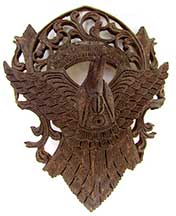
|
11.65 PATRIOTIC EAGLE CARVING. Splendid, incredibly detailed medallion of a spread wind eagle carved from a coconut shell! This superb little carving depicts the sailors' skills at their finest. Known for producing scrimshaw of unbelievable beauty, this folk art medium rivals the artistry of engraving and carving ivory. The eagle is shown in high relief with a sunburst banner enclosed by an arched foliate floral arch above. The detail is exquisite and bears scrutiny under magnification. Whereas scrimshaw is typically associated with marine mammal ivory and materials found aboard ship and/or in the whaling grounds, this example is clearly from the tropics where the bulk or scrimshaw in the 19th century was produced. 2 ½ inches wide by 3 ½ inches tall. Excellent, untouched, really amazing, original condition. 179 |
perspective |
detail |

|
11.57 SHIP IN A BOTTLE. Extra nice turn-of-the last-century ship in a bottle depicting a 3-masted bark flying the French flag from its after mast. This beautifully detailed example has a carved solid wooden hull plying a wavy green putty sea. The focs’le and poop deck have detailed life lines. The deck has two houses, the forward house has two life boats on top and its Charlie Noble issues smoke. The masts and spars are nearly to scale. The standing rigging is made in the traditional way with the lines being rove through the wooden components. Of particular note, this bottle diorama has a charming little tug boat on its port side forward belching very realistic smoke from its stack. Perhaps the most desirable feature of this example is the wonderful clarity of its molded glass whiskey bottle embossed “ONE QUART.” The bottom has additional markings which may indicate a date of 1894. The bottle is stoppered with a cork and sealed with blue sealing wax. 11 ¼ inches long by 3 ½ inches in diameter. One of the better ships in bottles we have encountered in the last several years. 649 |
detail |
perspective |
ship |
tug boat |

|
11.58 CARVED COCONUT. Unique, mid-1800’s or earlier, sailor-carved coconut from the South Pacific. This great example has precise meticulously-carved geometrical designs over its entire surface. The absolutely exacting designs speak of an incredibly-skilled craftsman. This type of “horn” was often used to carry black powder. There is no evidence here to suggest that was its function. More so, it was the work of a gifted sailor intended to impress. 5 by 4 inches. Perfect original condition. Worth much more! 396 |
bottom |

|
11.75 SEAM RUBBER. Particularly well executed mid-19th hand held tool used by a sailor to crease a fold in sail cloth prior to stitching. This genuine sailmaker's seam rubber is fashioned from a single piece of oak with an octagonally-faceted shaft, tapered "blade" and octagonal rounded knob. The shaft is drilled through, presumably to accommodate a thong. Adding to its charm and identification as sailor folk art, the knob is inlaid with a lovely disc of mother-of-pearl. This scarce instrument is rich with wear and patina attesting to years of actual use aboard a sailing ship. 4 1/2 inches long. A very charming tangible example sailing history. 229 |
 |
|
detail |
perspective |
reverse |

|
11.45 EXCEPTIONAL CARVED FRAME. Beautifully- carved and inlaid picture frame made from a single panel of rich African mahogany in the form of a ship’s lifering. This especially nice presentation features marguetry butterflies made of varietal woods inlaid on the left and right of the ring. The center features a rectangular opening for inserting a photograph, presumably of the sailor who carved it. Flanking each side of the opening are carved daisies with thistle-like flowers resembling anchors, above and below. At the top of the ring is the marguetry wood inlaid “HMS,” and the bottom “CODETIA.” The back is equipped with a hand-cut copper hanging bracket and 4 pivoting retaining wedges. 10 ¾ inches in diameter. Fabulous original, untouched condition exhibiting a great age patina. One of the best sailor folk art items we have ever come across. A real keeper! 195 |
reverse |

|
11.43 IDENTIFIED SEA CHEST. Truly exceptional 19th century seaman’s trunk with all the bells and whistles collectors avidly seek. This classic 6 board American chest has sloping “canted” sides made of New England pine with hand dove-tailed construction bearing its original chocolate brown paint. In true sea chest fashion it has a molded “skirt” on the lid which effectively prevented water from entering the top and a raised “kick board” bottom on all four sides which prevented water seeping in from the deck. The interior exhibits a single drawer till, iron lock and striker plate, and traditional old hand-forged strap hinges. The tour de force is the oil on sail canvas painting in the lid depicting the massive sailing bark at sea under full sail, identified below as the “4 . MAST . BARQUE .“EDWARD SEWILL (sic)” . BATH . MAINE . U.S.A.” The huge square rigger with towering skysail royals is shown flying the American flag from her spanker aft with a 3-funneled liner depicted in the distance. The character and execution of the painting is charmingly naïve with good attention to deck detail -- as expected of a sailor/artist. Several crewmen are depicted. The painting measures 26 by 16 ½ inches sight and is rimmed by another ½ inch strip of canvas held by numerous small tacks. Although the chest itself may be a half century older than its turn-of-the-century identification, the context of the time in which the painting was rendered must be considered. America had just won a resounding victory in the Spanish-American War. The Spanish fleet was decimated. Patriotic exuberance was at an all time high as the United States confidently entered the coming century as a world power. With that noted, the finishing touches of this sea chest’s beckets and cleats can be appreciated. The lovely extra large beckets are intricately woven of leather with Spanish hitching and Turks head knots. The decoratively-carved wooden cleats are painted with patriotic Union shields on both ends. 40 inches long by 16 ½ inches high. 17 inches wide at the base by 15 ½ inches wide on the lid. There are the typical cracks and nicks expected of a working sea chest well over 100 years old. But these are merely character marks, not considered to be damage. Accordingly this handsome chest can be rated as being in “excellent original condition.” There is no doubt that this sailor member of the merchant sail fraternity was extremely proud to be an American at sea. SOLD |
PERSPECTIVE |
FRONT |
BECKET |
TILL |
PAINTING |
DETAIL |
11.27 EXQUISITE POWDER HORN. Early 1800’s British seaman’s powder flask carved from the tough shell of a coconut. This extraordinary example is meticulously carved with the finest detail depicting several charming vignettes. Telling of its origins it shows a crown encircled by an oval double rope border near the bottom. Nearer the top is the carved inscription “MY HART” encircled by a rope border festooned with leaves and five-pointed stars top and bottom. Two conjoined hearts are pierced by arrows. These are flanked by two scaly serpents with arrows for tongues. There is a mythical beast adorning the top complete with scaly back, lizard legs, two open eyes, and a mouth made of faceted pewter which also serves as the flask’s spout. On either side are pewter mounting lugs which would have been attached to a strap for carrying. The remainder of the flask is adorned with any number of rosettes, vines, stars, recurring designs, pinwheels and two castles astride a plinth surmounted by pinwheels! Execution of the carving is of the first order. The fine detail is literally amazing, and bears close scrutiny under magnification – a true testament to the carver’s advanced skills! 5 ½ inches long by 4 ¼ inches in diameter. Fabulous original condition. Price Request |
DETAIL |
VINES |
MY HEART |
MOUTH |

|
11.35 HUGE IDENTIFABLE SHIP DIORAMA. The largest antique ship in a bottle we have ever seen! This early example of sailor folk art in a bottle dates from the turn-of-the-last century and undoubtedly depicts the one and only 5-masted sailing ship PREUSSEN. It features this exceptionally large 5-masted, square-rigged ship flying the American flag from the spanker boom aft, the house flag from the mainmast and a colorful pennant from the aftermast. The ship’s hull is carved from a single piece of wood, itself measuring 9 inches long inclusive of the bowsprit! It has 3 deck houses, a capstan on the foc’sle and two life boats on deck. The masts and spars are nicely proportioned and all rigging is intact. Steaming alongside the ship on its port side is a charming 2-masted vessel belching cotton “smoke” from its stack. In the background a large town consisting of 5 buildings and an imposing lighthouse is depicted. All of this is set in a colorful putty sea together with a cliff shoreline. This remarkable presentation is contained in a clear molded glass bottle with a greenish tinge, the top of which is embossed “ONE GALLON” and is sealed with its original cork stopper with tassel. It measures an impressive 13 ½ inches long by 5 ½ inches in diameter! Capping off this display, the bottle rests on its custom, solid teak stand of handsome proportion and finish with two supports done in the traditional way using mortise and tenon joints. The stand measures 14 3/8 inches long by 6 ¼ inches wide and is 1 1/4 inches thick. While the vessel in this diorama is depicted flying the American ensign, it was likely made in homage to PREUSSEN’s single visit to an American port in April 1908, when by all accounts she reportedly wowed New Yorkers with her size and unique design. |
PERSPECTIVE |
REVERSE PERSPECTIVE |
DETAIL |
SHIP |
STAND |
STAND BOTTOM |
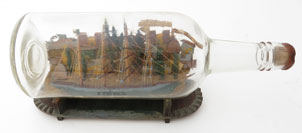
|
SHIP |
PERSPECTIVE |
STOPPER |
11.19 SAILOR'S NEEDLE CASE. Extra large 19th century sailmaker's needle case. This very fine example of working sailor folk art consists of a carved wooden tube with a matching "plug" cap which joins with a tight press fit. Over each is meticulously woven decorative Spanish hitching done in traditional sailor fashion known as McNamara work or "macramé." Such a covering was functional, providing a wear resistant, easily gripped covering which also spoke of the sailor's abilities as an accomplished seaman. This extra large specimen measures 8 ½ inches long by 1 ½ inches in diameter and is complete with 2 old sail canvas needles. One is triangular-shaped with English markings and the other has an unusual curved “spade” shape. Excellent original condition with a deep, rich old shellacked surface. A very handsome deck hand's needle case from the days of sail. Certainly one of the nicest examples currently on the market. 395 |
CONTENTS |
Also see catalog pages 2, 4 and 20 for more sailor-made folk art items


